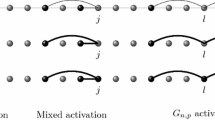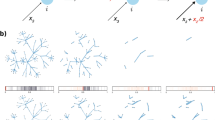Abstract
Recent experimental studies of living neural networks reveal that their global activation induced by electrical stimulation can be explained using the concept of bootstrap percolation on a directed random network. The experiment consists in activating externally an initial random fraction of the neurons and observe the process of firing until its equilibrium. The final portion of neurons that are active depends in a non linear way on the initial fraction. The main result of this paper is a theorem which enables us to find the final proportion of the fired neurons, in the asymptotic case, in the case of random directed graphs with given node degrees as the model for interacting network. This gives a rigorous mathematical proof of a phenomena observed by physicists in neural networks.
Similar content being viewed by others
References
Aldous, D., Bandyopadhyay, A.: A survey of max-type recursive distributional equations. Ann. Appl. Probab. 15, 1047–1110 (2005)
Aldous, D., Lyons, R.: Processes on unimodular random networks. Electron. J. Probab. 12, 1454–1508 (2007)
Amini, H.: Bootstrap percolation and diffusion in random graphs with given vertex degrees. Electron. J. Comb. 17, R25 (2010)
Balogh, J., Peres, Y., Pete, G.: Bootstrap percolation on infinite trees and non-amenable groups. Comb. Probab. Comput. 15, 715–730 (2006)
Balogh, J., Pittel, B.G.: Bootstrap percolation on the random regular graph. Random Structures & Algorithms 30, 257–286 (2007)
Bertoin, J., Sidoravicius, V.: The structure of typical clusters in large sparse random configurations. J. Stat. Phys. 135, 87–105 (2009)
Bollobás, B.: Random Graphs. Cambridge University Press, Cambridge (2001)
Breskin, I., Soriano, J., Moses, E., Tlusty, T.: Percolation in living neural networks. Phys. Rev. Lett. 97, 188102 (2006)
Cain, J., Wormald, N.: Encores on cores. Electron. J. Comb. 13, R81 (2006)
Cohen, O., Kesselman, A., Martinez, M.R., Soriano, J., Moses, E., Tlusty, T.: Quorum percolation in living neural networks. Europhys. Lett. 89, 18008 (2010)
Cooper, C., Frieze, A.M.: The size of the largest strongly connected component of a random digraph with a given degree sequence. Comb. Probab. Comput. 13, 319–337 (2004)
Eckmann, J.P., Feinerman, O., Gruendlinger, L., Moses, E., Soriano, J., Tlusty, T.: The physics of living neural networks. Phys. Rep. 449, 54–76 (2007)
van Enter, A.C.D.: Proof of Straley’s argument for bootstrap percolation. J. Stat. Phys. 48, 943–945 (1987)
Fontes, L.R.G., Schonmann, R.H.: Bootstrap percolation on homogeneous trees has 2 phase transitions. J. Stat. Phys. 132, 839–861 (2008)
Goltsev, A.V., Dorogovtsev, S.N., Mendes, J.F.F.: k-core (bootstrap) percolation on complex networks: critical phenomena and nonlocal effects. Phys. Rev. E 73, 056101 (2006)
Holroyd, A.: The metastability threshold for modified bootstrap percolation in d dimensions. Electron. J. Probab. 11, 418–433 (2006)
Janson, S.: The probability that a random multigraph is simple. Ann. Appl. Probab. 18, 205–225 (2008)
Molloy, M., Reed, B.: The size of the giant component of a random graph with a given degree sequence. Comb. Probab. Comput. 7, 295–305 (1998)
Newman, M.E.J., Strogatz, S.H., Watts, D.J.: Random graphs with arbitrary degree distributions and their applications. Phys. Rev. E 64, 026118 (2001)
Schwab, D.J., Bruinsma, R.F., Levine, A.J.: Rhythmogenic neuronal networks, pacemakers, and k-cores. Phys. Rev. Lett. (2008)
Soriano, J., Martínez, M.R., Tlusty, T., Moses, E.: Development of input connections in neural cultures, Proc. Nat. Acad. Sci. (2008)
Tlusty, T., Eckmann, J.-P.: Remarks on bootstrap percolation in metric networks. J. Phys. A, Math. Theor. 42, 205004 (2009)
Watts, D.J.: A simple model of global cascades on random networks. Proc. Natl. Acad. Sci. 99, 5766–5771 (2002)
Wormald, N.: Differential equations for random processes and random graphs. Ann. Appl. Probab. 5, 1217–1235 (1995)
Wormald, N.: The differential equation method for random graph processes and greedy algorithms. Lect. Approx. Random. Algorithms (1999)
Author information
Authors and Affiliations
Corresponding author
Rights and permissions
About this article
Cite this article
Amini, H. Bootstrap Percolation in Living Neural Networks. J Stat Phys 141, 459–475 (2010). https://doi.org/10.1007/s10955-010-0056-z
Received:
Accepted:
Published:
Issue Date:
DOI: https://doi.org/10.1007/s10955-010-0056-z




